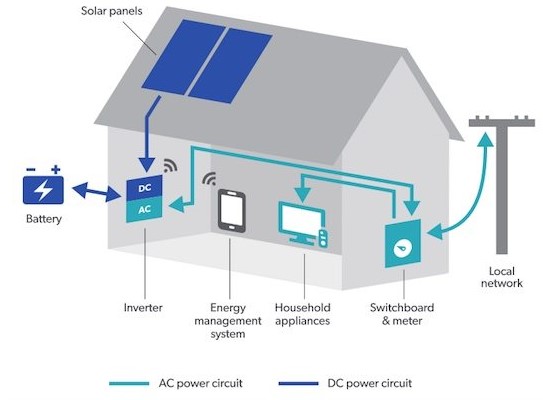HOW DOES BATTERY STORAGE WORK
What Is Battery Energy Storage?
Battery energy storage systems are rechargeable battery systems that store energy from solar arrays or the electric grid and provide that energy to a home or business. Because they contain advanced technology that regular batteries do not, they can easily perform certain tasks that used to be difficult or impossible, such as peak shaving and load shifting.


Charging Batteries with Solar
The idea of combining solar arrays and batteries is not new. Early solar pioneers often connected a series of marine deep cycle batteries to their solar arrays. Before net metering was widespread this was the only way to use stored solar energy at night. Modern battery energy storage systems are similar in concept, but much more sophisticated and powerful. If those old battery arrays were like flip phones, then modern battery energy storage systems are like the latest smartphone – they have the same primary function, but everything else is a world apart.
Modern battery energy storage systems usually include a built-in inverter and computerized control systems. This means they’re all-in-one, turnkey systems that are simple to install, largely maintenance-free, and don’t require any effort or expertise from the owner. They’re also weatherproof and safe for people and pets.
Applications – What Battery Storage Can Do
Residential applications include self-consumption, off-grid homes, and emergency backup.
Commercial applications include peak shaving, load shifting, emergency backup, and various grid services.
Residential Battery Energy Storage Applications
Commercial Battery Storage Applications
Technology – What’s Inside
Each energy storage unit contains several components: one or more battery modules, onboard sensors, control components, and an inverter. In DC coupled units, a separate inverter is used. In AC coupled units, the inverter is integrated into the system. These components make energy storage systems more than mere batteries.
Multiple, swappable battery modules prevent an entire energy storage unit from going down if one battery module fails. The module can be swapped out for another with no downtime.
Sensors ensure safe operation and allow for remote monitoring. Onboard sensors help maintain appropriate operating temperatures, watch for battery module failure, and report usage data to you and your energy company.
Control components mean energy storage systems can be set up however they need to be to perform their intended job without any ongoing user intervention. For example, batteries can be configured to charge automatically when energy is cheapest and discharge automatically when it’s most expensive, or they can be configured to simply store energy in case of a power outage.
Integrated inverters make installation easy and inexpensive. While DC coupled battery storage systems with separate inverters can be cheap, efficient, and good for off-grid homes, they offer much less flexibility than AC coupled units with integrated inverters. AC coupled units, like Tesla’s Powerwall 2, have more capabilities, work without solar arrays, and are easier to install. Modern systems simply plug into an existing power network.
Best-in-class energy storage systems – have a few more key components: built-in cooling systems, weatherproof construction, and scalable architecture.
Built-in cooling ensures optimal performance. Weatherproof construction means energy storage systems can be mounted outside without the added cost of protective structures. Scalable architecture means multiple energy storage units can be linked to form a larger system. Additional units can always be added later.
Taken together, these components make battery energy storage systems safe, scalable, and cost-effective.
Opportunity – Transforming Our Energy Future
We believe battery energy storage systems will radically transform the way we interact with energy. They’ll make solar energy a no-brainer for many more homes and businesses, bring greater independence from traditional utilities, and open the door to a great diversity of energy options.












